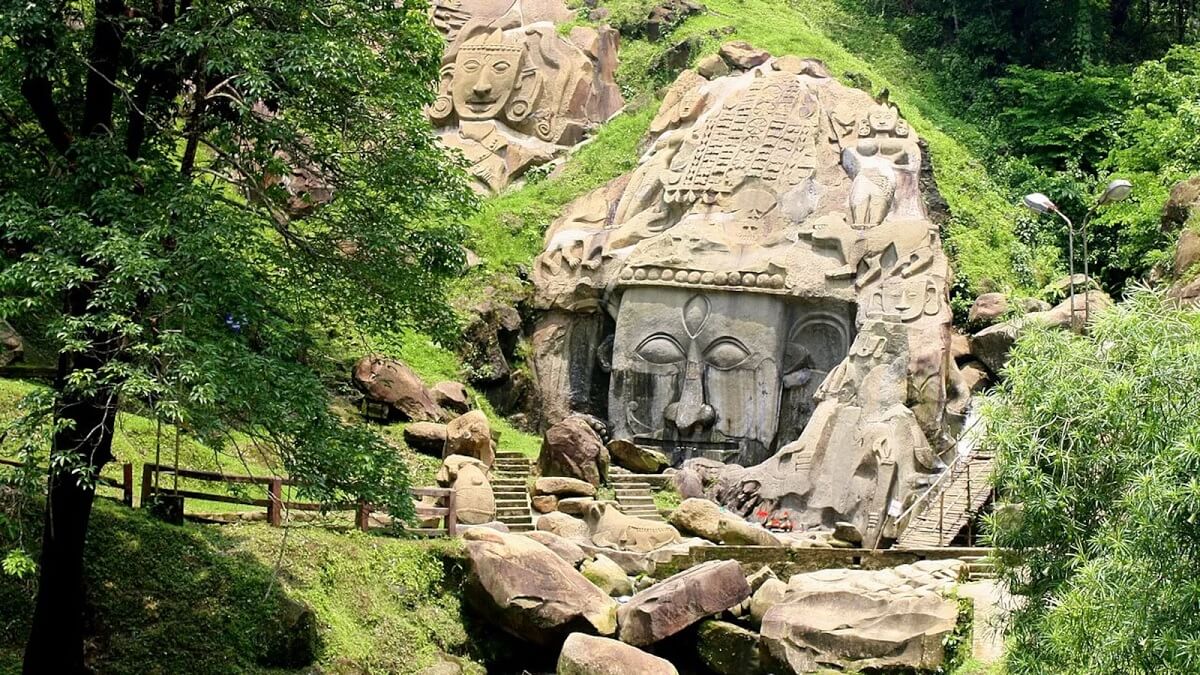
Unakoti, located in the Kailashahar subdivision of Tripura, is a fascinating archaeological and pilgrimage site famous for its massive rock-cut sculptures and stone carvings dating back to the 7th–9th centuries. The name "Unakoti" literally means "one less than a crore," and local legend says that Lord Shiva once halted here with 99,99,999 gods and goddesses on his way to Kashi, but only he woke up in time — the rest were turned to stone. This mythical backstory adds a layer of mystique to the site’s already awe-inspiring charm.
The highlight of Unakoti is the towering 30-foot-high bust of Lord Shiva, known as Unakotiswara Kal Bhairava, along with intricate carvings of deities like Goddess Durga and Ganesha. The artistry reflects both religious devotion and the cultural heritage of ancient northeastern India. The carvings, etched into lush green hills, are surrounded by waterfalls and forest, creating a magical blend of history and nature.
The site is also an important pilgrimage destination, particularly during the annual Ashokashtami Mela, which attracts devotees from across the region. During this festival, the area comes alive with rituals, prayers, and cultural programs, making it the best time for visitors who want to witness its spiritual vibrance. For those more inclined toward heritage tourism, the peaceful environment outside of festival days offers an excellent chance to explore and photograph the carvings without large crowds.
Best time to visit: October to April

Neer Mahal, often called the "Lake Palace of Tripura," is a stunning water palace located in the middle of Rudrasagar Lake, around 53 km from Agartala. Built in 1930 by Maharaja Bir Bikram Kishore Manikya as his summer retreat, this architectural marvel blends Hindu and Mughal styles, much like Rajasthan’s famous palaces but with a serene lakeside charm. The name "Neer Mahal" literally means "Water Palace," and its white structure reflecting on the calm waters creates a dreamlike view, especially at sunrise and sunset.
The palace is divided into two sections — the western side for royal residence and the eastern side for cultural programs and performances. Surrounded by lush gardens, open terraces, and decorative towers, Neer Mahal offers visitors a glimpse into the luxurious lifestyle of Tripura’s former royalty. Its setting in the middle of the lake means that visitors must take a boat ride to reach it, adding a sense of adventure and romance to the experience.
Neer Mahal is also known for hosting the Neermahal Water Festival, a colorful event held twice a year in August and December. During the festival, visitors can enjoy boat races, cultural dances, and music performances, making the place even livelier. Birdwatchers also find the lake surroundings attractive during winter when migratory birds arrive, enhancing its natural beauty.
Best time to visit: October to March or August and December
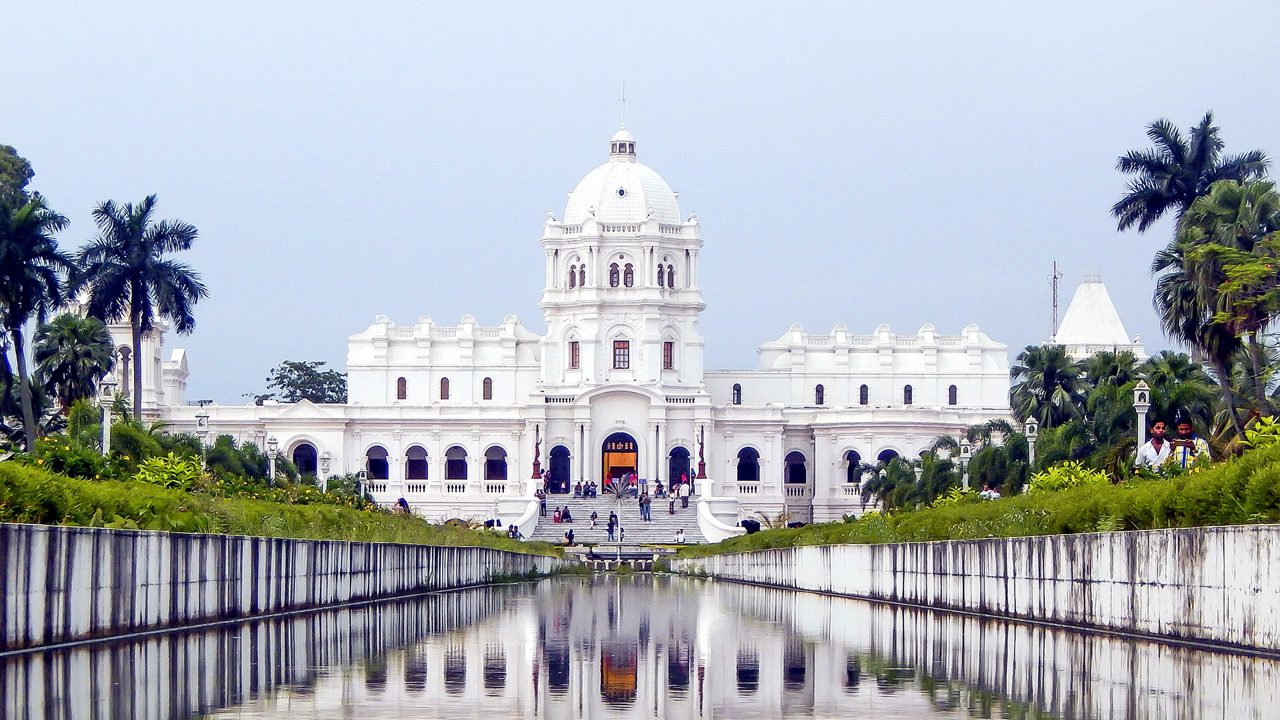
Ujjayanta Palace, located in the heart of Agartala, is one of Tripura’s most iconic landmarks and a proud reminder of its royal heritage. Built in 1901 by Maharaja Radha Kishore Manikya, the palace showcases a stunning mix of Mughal and Indo-European architectural styles. Its white domes, elegant wooden ceilings, tiled floors, and sprawling gardens make it a visual delight. The name “Ujjayanta” was given by Nobel laureate Rabindranath Tagore, adding to its cultural significance.
The palace was once the royal residence of the Manikya dynasty but today houses the Tripura State Museum, which showcases the state’s history, tribal traditions, and cultural artifacts. Visitors can explore exhibitions on Tripura’s archaeological finds, traditional attire, musical instruments, and ancient sculptures. The palace complex also features artificial lakes, fountains, and landscaped gardens, making it a peaceful spot for an evening stroll.
Ujjayanta Palace is especially beautiful when illuminated at night, its reflection shimmering in the surrounding lakes. The grand Durbar Hall and Chinese Room inside the palace stand out for their intricate designs and opulent interiors. The museum’s well-curated displays make it an educational as well as a scenic destination, appealing to both history enthusiasts and casual travelers.
Best time to visit: October to March
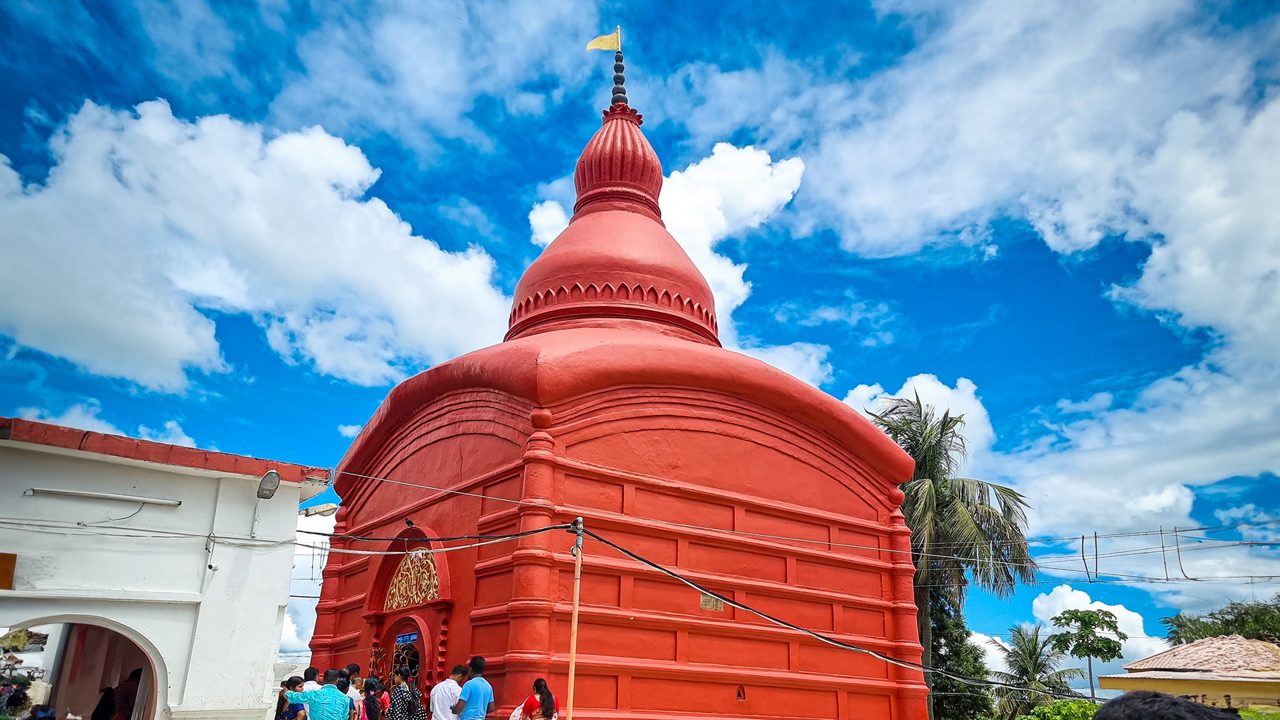
Tripura Sundari Temple, located in Udaipur about 55 km from Agartala, is one of the most revered pilgrimage sites in Tripura and among the 51 Shakti Peethas in India. Dedicated to Goddess Tripura Sundari, a form of Goddess Kali, the temple is believed to be over 500 years old and was built by Maharaja Dhanya Manikya in 1501 AD. Its architecture follows the traditional Bengali hut-style, with a square sanctum topped by a conical dome, giving it a distinctive charm.
The temple houses a beautiful idol of the Goddess made of black stone, locally known as “Soroswati,” and is worshipped in the form of Soroshi by devotees. Surrounding the temple is the sacred Kalyan Sagar Lake, home to large fish and turtles that are considered holy and are often fed by visitors. The temple is not only a place of worship but also an important cultural landmark, attracting thousands of pilgrims each year, especially during Diwali when the grand Diwali Mela is held.
Tripura Sundari Temple exudes an aura of peace and divinity. The rhythmic sound of temple bells, the fragrance of incense, and the sight of devotees offering prayers create a deeply spiritual atmosphere. The temple’s serene surroundings and the calm waters of Kalyan Sagar make it an ideal spot for meditation and quiet reflection.
Best time to visit: October to March
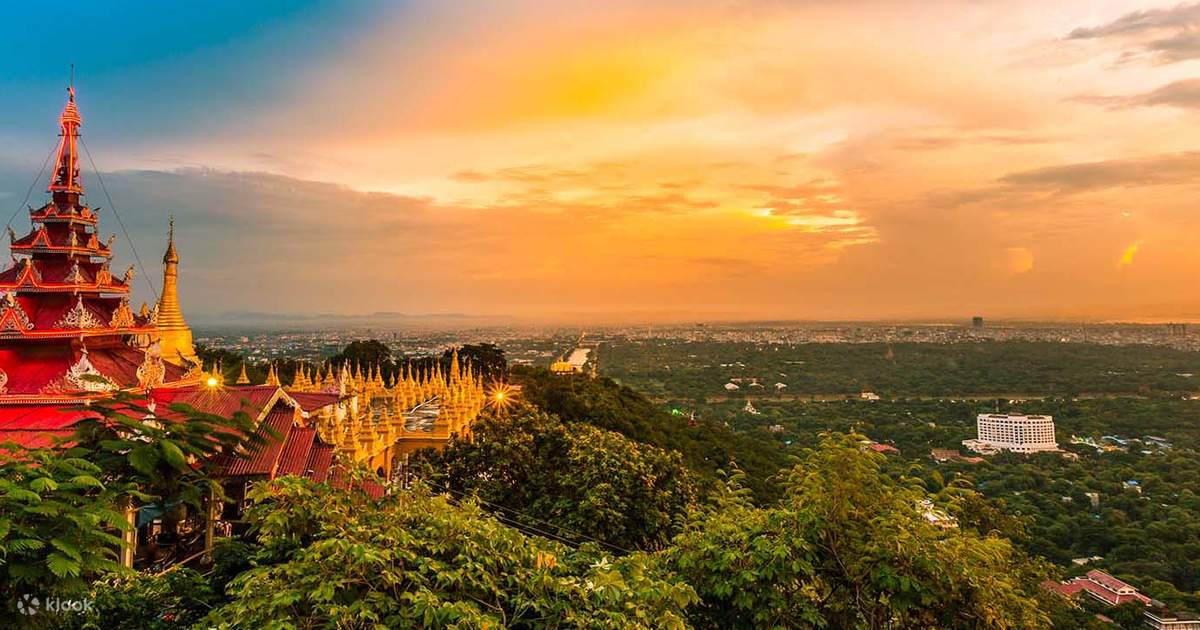
Mahamuni Buddha Mandir, located near Manubankul in South Tripura, is a significant Buddhist pilgrimage site that holds great spiritual importance for followers of Buddhism in Northeast India and beyond. The temple is dedicated to Lord Buddha and is believed to house one of the sacred statues said to have been cast during Buddha’s lifetime. According to local legends, the idol was brought to this region centuries ago, making the temple a revered place of worship.
The architecture of Mahamuni Buddha Mandir blends traditional Buddhist design elements with local Tripuri influences. The temple complex features a golden-roofed shrine, intricately decorated prayer halls, and serene gardens. Colorful prayer flags flutter in the wind, adding to the temple’s tranquil charm. The site is not only a center for spiritual practice but also a cultural meeting point for people from Tripura, Mizoram, Myanmar, and even Thailand who visit for worship and festivals.
One of the most significant events here is the Mahamuni Festival, held annually in January or February. This vibrant three-day celebration draws thousands of devotees who participate in prayers, meditation sessions, cultural performances, and fairs. The festival also fosters cultural exchange between different Buddhist communities of the region.
Best time to visit: November to February
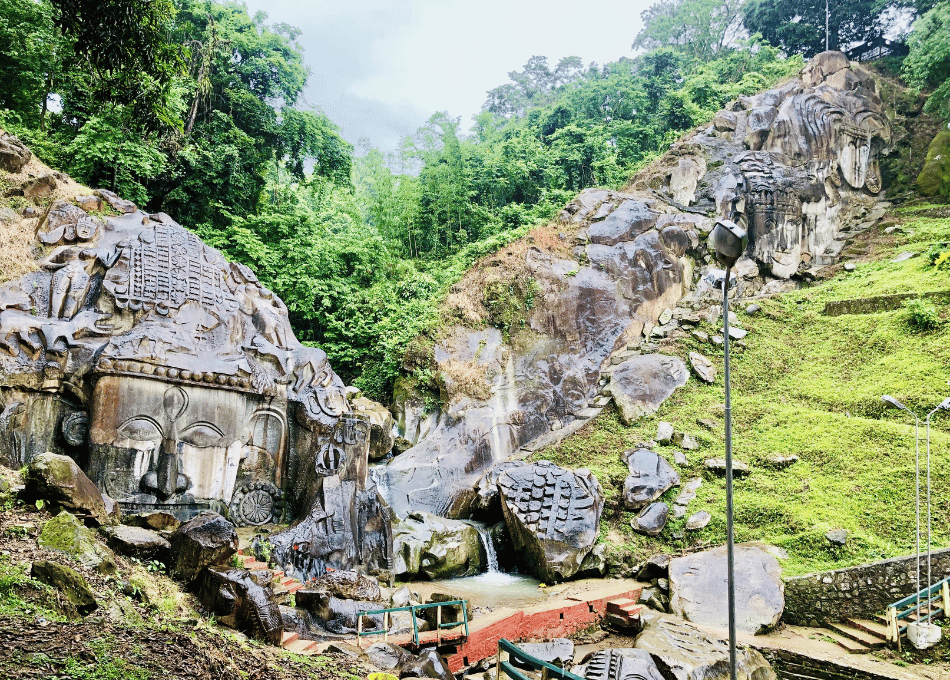
Devtamura, located in the South Tripura district, is an archaeological and historical wonder known for its magnificent rock carvings that date back to the 15th–16th centuries. This hill range, rising above the Gomati River, houses over 37 carved panels depicting Hindu deities such as Durga, Ganesha, and Mahishasura Mardini. These ancient carvings are etched on the steep rocky faces of the hills, making Devtamura a unique open-air art gallery that reflects the region’s rich cultural and religious heritage.
To reach the carvings, visitors typically take a scenic boat ride along the Gomati River, surrounded by lush greenery and calm waters. The journey itself is as memorable as the destination, offering panoramic views of the hills and forested landscapes. Once at the site, you can witness the detailed craftsmanship of the rock reliefs, which stand as a testament to the skill of the ancient sculptors and the strong influence of Hinduism in Tripura’s past.
Devtamura is also associated with local legends and myths, adding a mystical aura to the place. The annual Garia Puja, celebrated by the local tribes, is an important cultural event in the region, showcasing traditional rituals, music, and dance. Nature lovers will also appreciate the biodiversity of the surrounding forests, which are home to various species of flora and fauna.
A visit to Devtamura offers a perfect blend of history, spirituality, and nature. It is an ideal destination for those interested in archaeology, art, and offbeat travel experiences in Northeast India.
Best time to visit: November to March
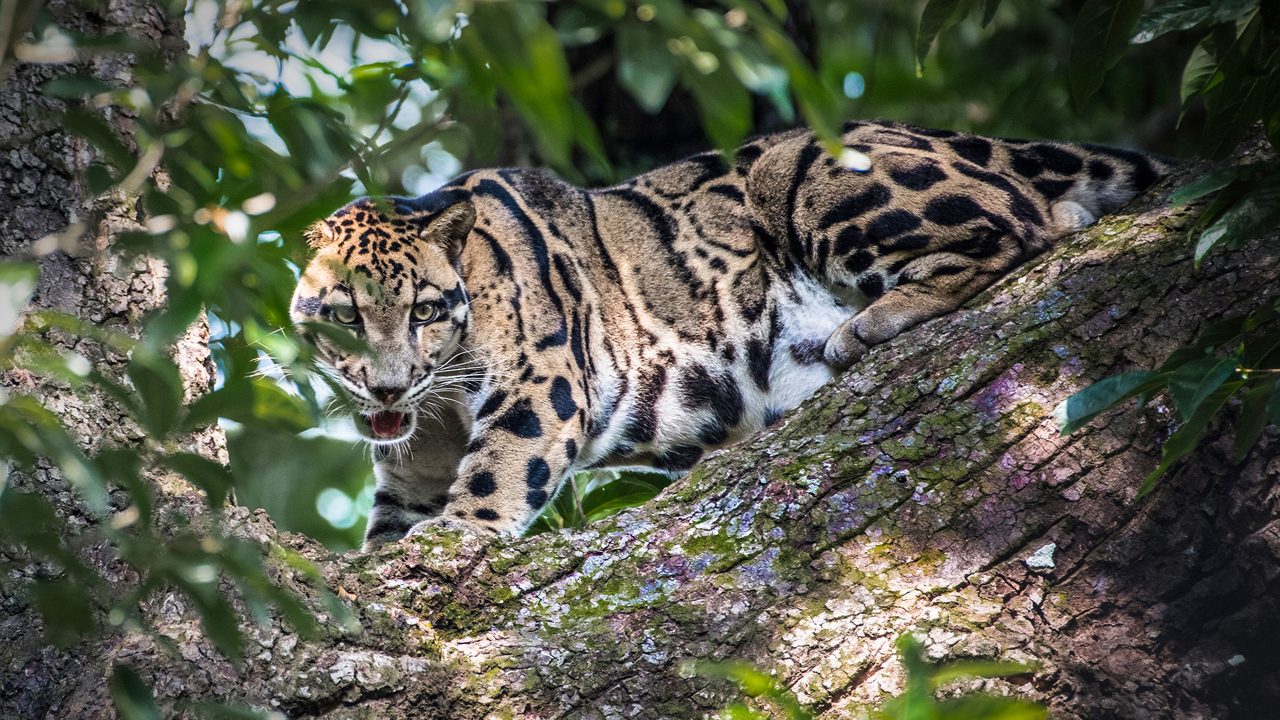
Sipahijola Wildlife Sanctuary, located about 25 km from Agartala in Tripura, is a picturesque haven for wildlife enthusiasts and nature lovers. Spread over an area of about 18.5 square kilometers, the sanctuary is known for its diverse habitats, including forests, lakes, and botanical gardens. It is home to a wide variety of animals such as clouded leopards, barking deer, civets, primates like the Phayre’s langur, and several bird species. The sanctuary also houses a zoological park, botanical garden, and a deer park, making it a popular destination for both education and recreation.
One of the main attractions here is the Clouded Leopard National Park within the sanctuary, dedicated to the conservation of this rare and elusive species. The sanctuary is also blessed with rich flora, including bamboo groves and orchids, creating a refreshing environment for visitors. Several watchtowers are set up to help tourists observe wildlife in their natural surroundings without causing disturbance.
Sipahijola is not just about animals—it’s also a paradise for birdwatchers. Migratory and resident birds can be spotted around the lakes, especially during the winter months. The tranquil lakes within the sanctuary offer boating facilities, making it an ideal place for families and photographers. The combination of wildlife, scenic beauty, and recreational facilities makes Sipahijola a well-rounded tourist spot.
Best time to visit: November to March
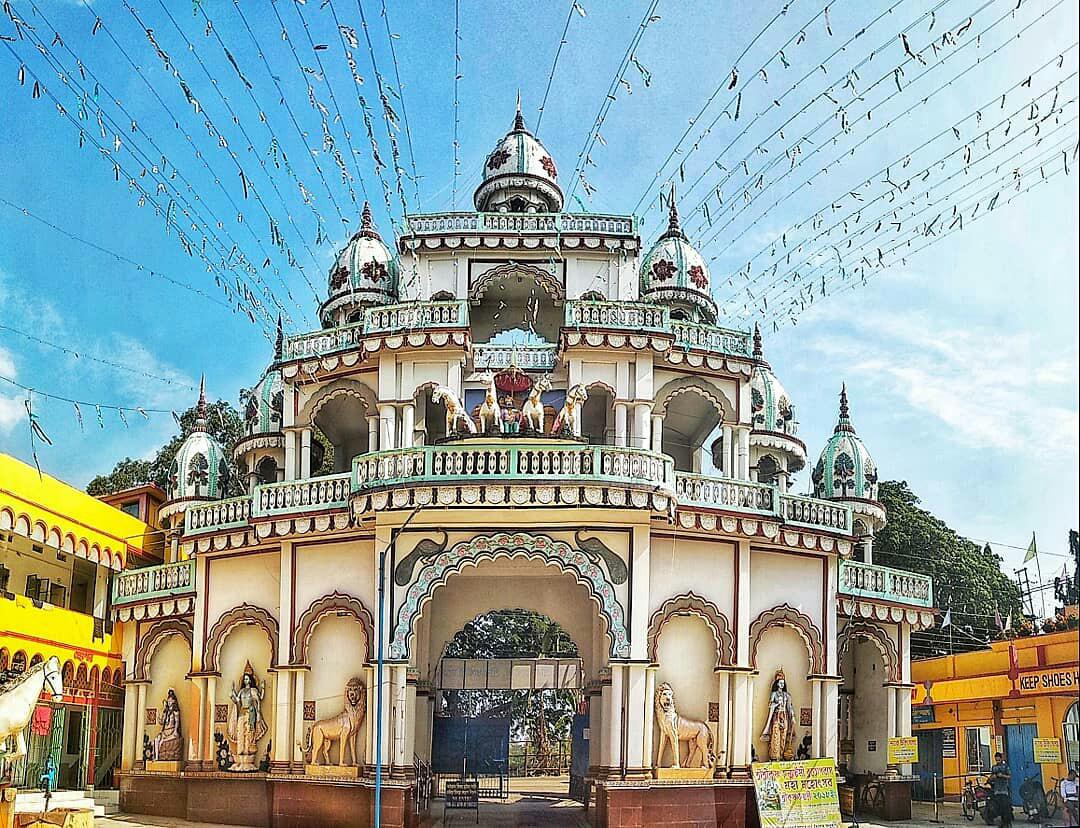
The Jagannath Temple in Tripura, located in the Ujjayanta Palace grounds in Agartala, is a beautiful place of worship dedicated to Lord Jagannath, along with his siblings Balabhadra and Subhadra. Built in the late 19th century by Maharaja Radha Kishore Manikya, the temple reflects a blend of Hindu and Islamic architectural styles. Its octagonal base and bright orange façade make it stand out, while the sanctum sanctorum houses the deities in traditional Puri-style arrangements. The temple is not only a religious site but also a significant historical and cultural landmark in the state.
The temple is especially lively during the annual Rath Yatra (Chariot Festival), when devotees pull the chariots carrying the deities through the streets, accompanied by music, chants, and festivities. The atmosphere during this time is filled with devotion and joy, attracting not only locals but also tourists from other parts of India. The celebrations here mirror those of the famous Jagannath Temple in Puri, Odisha, though on a smaller scale.
The surrounding area of the temple, being part of the Ujjayanta Palace complex, offers a serene and green environment. Visitors often explore the palace grounds before or after offering prayers at the temple. The structure’s artistic detailing and peaceful ambiance make it a pleasant stop for both pilgrims and travelers interested in architecture and history.
A visit to the Jagannath Temple is a chance to witness Tripura’s cultural diversity and spiritual heritage. Whether you come during the Rath Yatra or on a quiet day, the temple offers a soulful and enriching experience.
Best time to visit: October to March and June-july
Trishna Wildlife Sanctuary, located in the South Tripura district, is a pristine haven for nature lovers and wildlife enthusiasts. Spread over an area of around 163 square kilometers, it was established in 1988 and is known for its rich biodiversity. The sanctuary is home to the endangered Indian Gaur (bison), which is its main attraction, along with a variety of other species such as deer, hoolock gibbons, wild cats, and numerous reptiles. Its landscape features patches of tropical semi-evergreen forests, grasslands, bamboo groves, and perennial water sources, making it a thriving habitat for both flora and fauna.
For birdwatchers, Trishna Wildlife Sanctuary is a paradise, as it shelters over 150 species of birds, including migratory varieties during the winter months. The sanctuary’s wetland areas attract a range of aquatic birds, adding to its avian diversity. Seasonal streams and waterholes make it an important ecological zone, sustaining wildlife even during dry months. The scenic beauty and peaceful environment make it a perfect escape from busy city life.
Adventure seekers can enjoy guided jungle safaris, nature walks, and photography expeditions here. The forest department organizes eco-tourism activities to help visitors explore the sanctuary’s beauty while promoting conservation awareness. The sanctuary also has small tribal villages nearby, offering a glimpse into the culture and lifestyle of the local communities.
Best time to visit: November to March
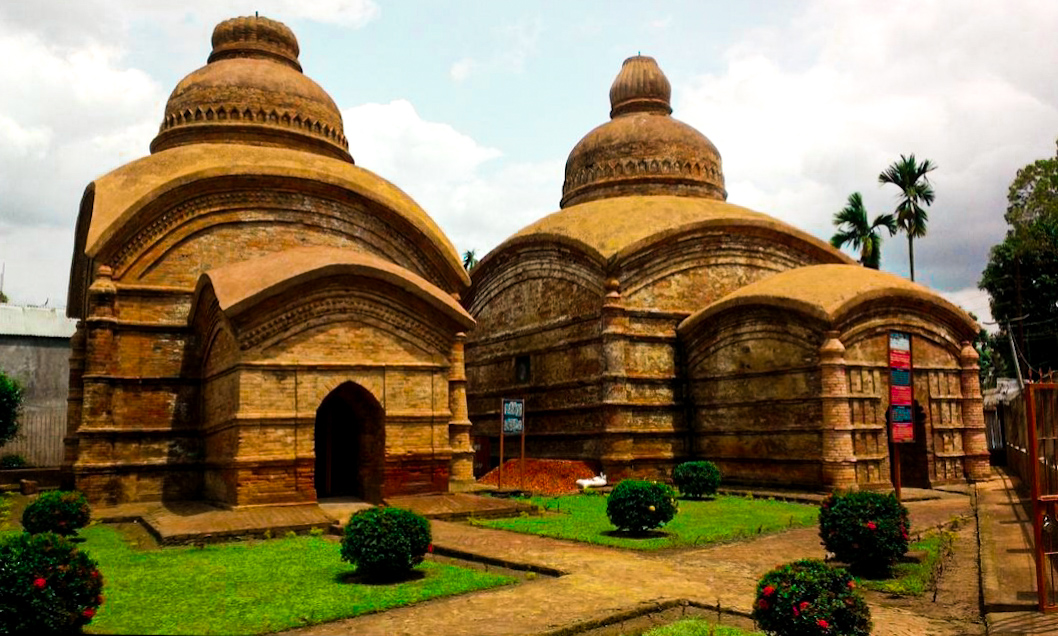
The Gunavati Group of Temples, located in Udaipur of Tripura’s Gomati district, is a historically significant site that reflects the region’s rich architectural and cultural heritage. Believed to have been built during the reign of Maharaja Govinda Manikya in the 17th century, these temples are dedicated to Hindu deities and exhibit the unique Tripuri temple style. The name “Gunavati” is associated with one of the queens of the Maharaja, and the complex holds a deep connection to the royal legacy of the Manikya dynasty.
The temple structures are adorned with intricate carvings and traditional designs, representing a blend of local craftsmanship and Bengal-influenced terracotta patterns. Even though many parts of the complex have weathered with time, the artistry and devotion reflected in its construction remain evident. Surrounded by a tranquil rural landscape, the site offers a serene atmosphere, making it ideal for those seeking spiritual peace and historical exploration.
Apart from their religious importance, the Gunavati Group of Temples also attracts history enthusiasts and architecture lovers. The temples stand as a testimony to Tripura’s medieval glory and its cultural connection with the Vaishnavite traditions. The location provides a unique opportunity to observe how faith and art merged during that period.
Best time to visit: October to March
